
- Feature
- Posted
Seeing the wood for the trees - Placing ecology at the heart of construction
In recent years, as energy efficiency targets for new buildings have tightened, attention has turned to cutting the embodied carbon of buildings by switching from materials like concrete and steel to lower carbon alternatives like timber. But if we are serious about solving the ecological emergency as well as stabilising the climate, we must look even further than embodied carbon, and think more deeply about the core values we apply to materials and buildings, and the manner in which we use them.
By Lenny Antonelli & AECB CEO Andy Simmonds
This article was originally published in issue 39 of Passive House Plus magazine. Want immediate access to all back issues and exclusive extra content? Click here to subscribe for as little as €10, or click here to receive the next issue free of charge
On 30 May 2019, British architects Steve Tompkins and Michael Pawlyn launched the Architects Declare pledge, now widely shared in the industry, which states that, “the twin crises of climate breakdown and biodiversity loss are the most serious issues of our time.”
It continues: “For everyone working in the construction industry, meeting the needs of our society without breaching the earth’s ecological boundaries will demand a paradigm shift in our behaviour. Together with our clients, we will need to commission and design buildings, cities and infrastructures as indivisible components of a larger, constantly regenerating and self-sustaining system.”
Since spreading to become the wider #ConstructionDeclares and #BuiltEnvironmentDeclares pledges, it has been signed by almost 7,000 companies across the global building industry.
The first issue addressed in the pledge, climate breakdown, is an ever-growing focus for the construction sector — as evidenced by tightening energy efficiency regulations for new buildings, the growth of standards like passive house, and the more recent push to measure and limit embodied carbon. But the second issue, the biodiversity emergency, still remains largely unaddressed by the industry.
What is the biodiversity emergency?
The ecological crisis is just as immediate as the climate crisis. Global populations of vertebrate animals have declined by an average of 60 per cent since 1970. Just three per cent of global land ecosystems remain intact, while the world’s total mass of insects is falling by a rate of about 2.5 per cent annually, threatening a collapse of nature, scientists say. Destruction of primary rainforest is also accelerating, and the Amazon rainforest is nearing a point of irrevocably switching from canopy rainforest to open grassland.
If climate change has been a rather nebulous concept, ecological collapse is arguably more so. It is happening all around us, yet is easy to miss because we are so disconnected from nature. It also challenges the idea that we can ‘fix’ environmental crises through technological solutions, instead requiring a complete reinvention of our relationship with food, materials, and the rest of the living world.
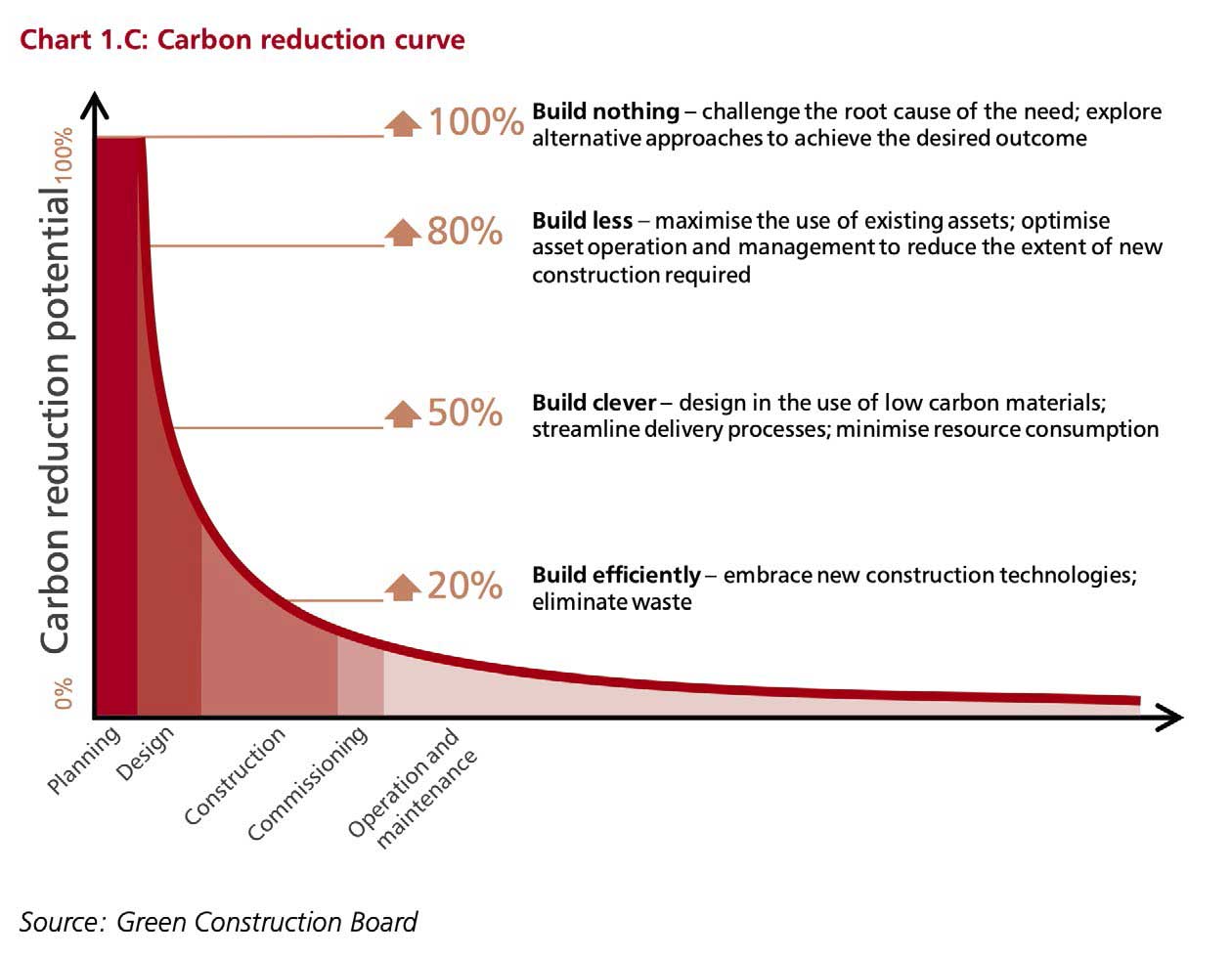
Hierarchy of ways to reduce the carbon footprint of construction. Source: HMTreasury (2013) and Green Construction Board (2013).
Knowing how to respond effectively to ecological collapse is difficult from within a technological and growth-based mindset. But just like reducing our consumption of meat and dairy, which generally require more land than plant-based foods and thus put greater pressure on natural habitats, we can also seek to limit the area of land, and the quantity of raw natural resources, required to produce and maintain our buildings. We can also explore specifying materials that are, or could be, produced as integrated by-products of healthy ecosystems.
Half Earth
The importance of simply setting aside more land for nature, free of extractive human use, should not be underestimated. It is perhaps best exemplified by the ‘Half Earth’ idea devised by EO Wilson, the great evolutionary biologist, which proposes setting aside half the planet for nature.
Wilson was one of the developers of island biogeography theory, one of the most important ideas in twentieth century ecology. This states that the smaller an island of habitat is — think a natural forest surrounded by monocultures of wheat — and the further it is from other habitat islands, the fewer species it will support.
“When 90 per cent of habitat is removed, the number of species that can persist sustainably will descend to about a half,” Wilson’s project website, half-earthproject.org, states. “If on the other hand, we protect half the global surface, the fraction of species protected will be 85 per cent, or more. At one-half and above, life on earth enters the safe zone.”
Wilson’s Half Earth idea has captured the imagination of many, but also been criticised by those questioning whether, if deployed, it could lead to the displacement of poorer people in the majority world. One study concluded that one billion people live in areas that the project has earmarked for protection and restoration. How they would be affected depends on the type of management envisioned for these areas.
Whatever its flaws, the Half Earth idea does at least make clear the scale of action needed to restore the earth’s living systems. Half Earth also has an important principle at its heart: that we share the planet with other species, and that we might seek to limit our own footprint to make space for them. Ecological restoration must now be at the heart of everything we do, including construction.
And it cannot just focus on the world’s last remaining biodiversity hotspots in the tropics. If we expect developing nations to save their last wild habitats in the interests of a stable biosphere, we must lead by example and restore our own depleted ecosystems here in western Europe.
Embodied carbon: just the beginning
As the building industry seeks to lower its carbon footprint, it has increasingly looked to timber as an alternative to materials like plastics, fired clay, concrete and steel. As well as causing less pollution in manufacture, timber-based products can be sourced from well-managed forests and woodlands, which draw down carbon as they grow. This atmospheric carbon is sequestered in the tissues of trees’ roots, trunks, branches, and leaves.
The current thinking in our industry is that where timber extraction from a forest is managed in a sustainable manner, under the various certification schemes, that growing trees for long-term uses such as construction can ‘be good for the climate’. Construction timber is of particular interest in climate conversations because of its longevity: carbon in shorter-lifespan products, such as pulp, paper, pallets, woodchip and fencing, is generally returned to the atmosphere much sooner.
Venerable research bodies, including the Intergovernmental Panel on Climate Change (IPCC), the Royal Society, the Potsdam Institute, and the Committee on Climate Change (CCC) have endorsed strategies of using more timber in the built environment.
However, switching from energy and carbon intensive materials to timber and other natural fibres must be just the starting point, rather than the end point, of our journey to explore ever more ecological ways of creating and refurbishing buildings. Beyond the concepts of ‘up front’ and ‘embodied’ carbon, we must develop our understanding of the land-footprint of the resources we use, and their wider impact on the living world.
While Environmental Product Declarations (EPDs) now thankfully provide us with a lot more information about the environmental impact of construction products — including climate warming, acidification, eutrophication and resource depletion — they do not yet include any specific metric for biodiversity loss, a difficult parameter to measure and present meaningfully. (An impending update to how EPDs are calculated, however, will introduce a requirement to include carbon emissions resulting from direct land use change in a product’s life cycle. It will also remove the ability to claim carbon sequestration if wood is sourced from a native forest not otherwise managed for timber extraction).
Restoring flourishing ecosystems while transitioning from a growth-driven economy to an equitable circular and sustainable society — one that works within the planet’s ecological limits — is an urgent task, yet it is also a job that will take decades. For a safe climate, and the restoration of nature, we will need many years of social, natural and economic rehabilitation — along, mostly likely, with periods of fossil fuel “cold turkey”.
This presents humanity with our greatest creative challenge. Rising to it is not a chore but potentially our best opportunity in half a century for a renewed sense of meaning and purpose. Our industry’s immediate tasks include radically reducing the operational and embodied energy of all construction.
In addition, we are likely to have to fully decommission some of our most polluting infrastructure, salvaging what we can from the dismantling. The fossil fuel valves must be turned down each year, and will have to be almost completely closed within a decade to avoid the nightmare of a world with more than 1.5 C of warming.
The reality is that we also need to minimise the area of land and the quantity of raw natural resources required to produce our buildings. And while material substitution — replacing high embodied carbon materials with lower embodied carbon ones — is important, it will never be sufficient within a growth-driven system. And it is not more important than fundamental measures such as building less and building more modestly, prioritising the retrofit of existing infrastructure, developing a genuine circular economy for building materials, and creating low land-use, zero-carbon construction materials.
This is the essence of the challenge facing us: we need to use human ingenuity and our inherent ability to cooperate to do more with less, in order to live safely within the ecological limits of the Earth. We suggest the following framework of principles to guide building design, and selection of materials.
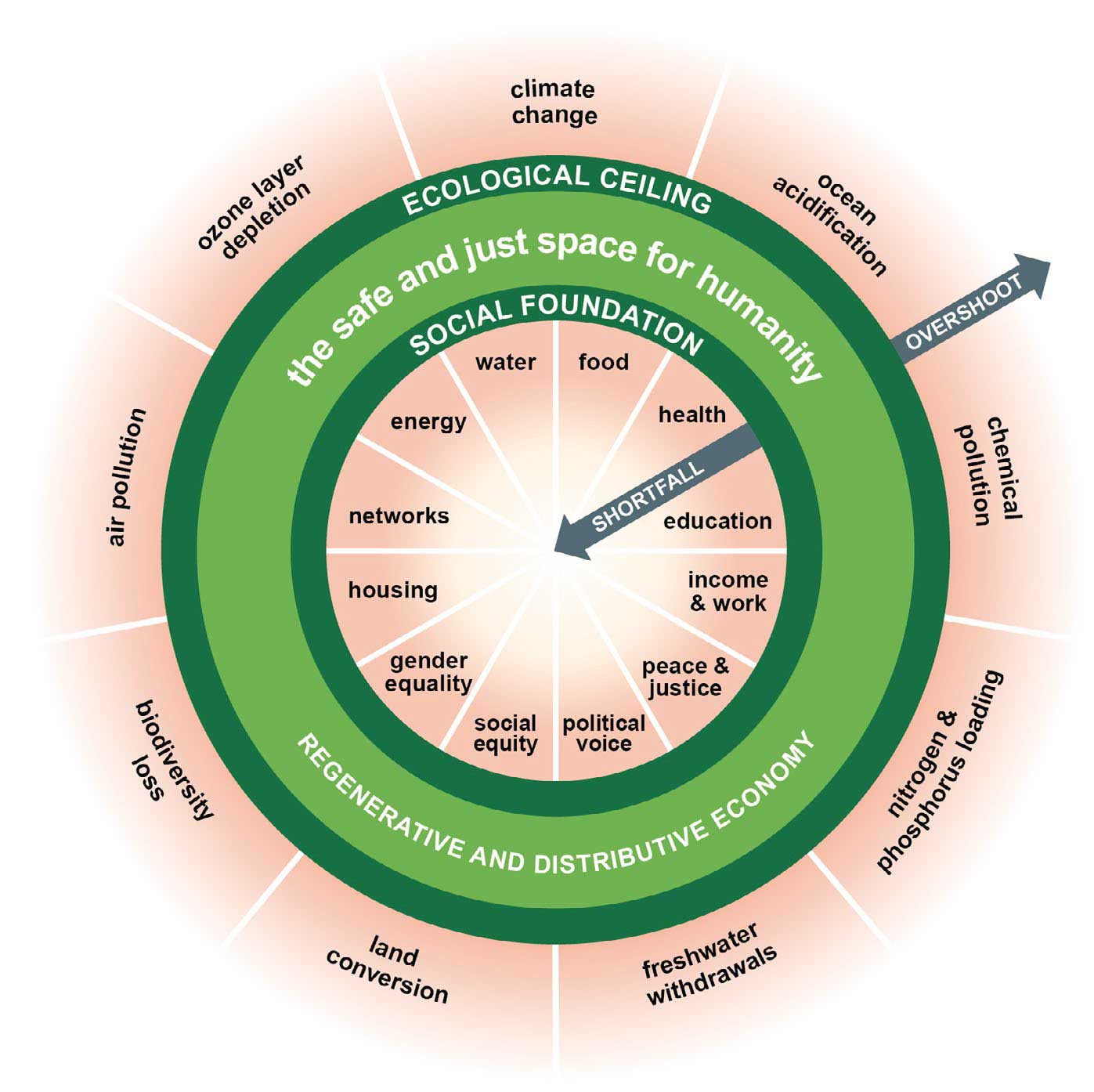
The Doughnut Economics framework, which aims to ensure the basic needs of all people are met while not exceeding the earth’s environmental capacity, can be used to help guide decisions on when new construction is needed.
1. Sufficiency
Before building something, we should start by asking if it is really needed, and if there any strategic alternatives to the brief. Discuss this early, once you have your client’s trust. Prepare and signal your ‘sophisticated sufficiency’ arguments in advance and market them cleverly. Can existing structures be reused first or retrofitted first before creating something new?
We encourage everyone to critically examine claims about the need for new buildings, particularly when a project seems to be designed simply to provide a return on capital, rather than benefitting people or nature. Even if we replace polluting materials with “greener” ones, we will not solve the ecological crisis if growth, profit and inequality remain the dominant values in our society and economy.
In its 2019 report on tackling the UK housing crisis, the UK Collaborative Centre for Housing Evidence concluded that the goal of building 300,000 new homes annually in the UK would not lead to a significant drop in prices, but would lead to more empty homes. A report from the think tank Green House reached similar conclusions.
This is not to say that new construction is never required, sometimes even on a significant scale, but such claims must be critically scrutinised. We suggest employing the Doughnut Economics framework of ensuring the basic needs of all people are met, while not exceeding the earth’s environmental carrying capacity, to ensure all development remains within the ‘safe and just space’ for humanity. This framework will become increasingly important as we seek to meets the material needs of all people, and improve living standards for those in the majority world, while restoring the biosphere.
2. Simplicity
Designing and building as simply as possible — true value engineering or “integrated design”. Asking: can this building be made simpler and more modest? Can the building be smaller or use less materials through innovative engineering approaches?
3. Circular economy
Explore circular design approaches. Design realistically for reuse and disassembly, be open about your assumptions for the end-of-life stage of buildings and products, in order to facilitate wider discussion and development. Design buildings to last a long time, or at the very least, to be easily disassembled and their parts easily reused. For example, can insulation and other materials be easily separated, with significant value retained, and be reused or repurposed at the end of the building’s life? At the very least design and build to facilitate easy recycling — incineration for energy should be the very last resort.
4. Efficiency – only take what you need
Use natural resources extracted from our shared biosphere respectfully and efficiently to substitute for higher embodied carbon materials. Use as few materials as possible to achieve the design. Using a “renewable” material inefficiently, whether to ‘develop the market’ or ‘store carbon’ is wrongheaded – efficient use of the same quantity of material, substituting for higher carbon options across many projects, makes far more sense.
Use natural resources extracted from our shared biosphere respectfully and efficiently.
The latest State of Europe’s Forests report, by the pan-European body Forest Europe, says that European forests are expanding, storing carbon, and supplying wood on a “sustainable basis”. The area of forest in Europe has increased by 9 per cent over the last 30 years and the amount of carbon it stores has grown by half in that time. The forest area protected for biodiversity stands at 24 per cent and growing. But the report warns that threats associated with global heating — droughts, heat-waves, bark-beetle outbreaks, and forest fires — are now a major risk. It says there is a limit to the capacity of forests to respond to increased demand for wood products, carbon sequestration, and other functions.
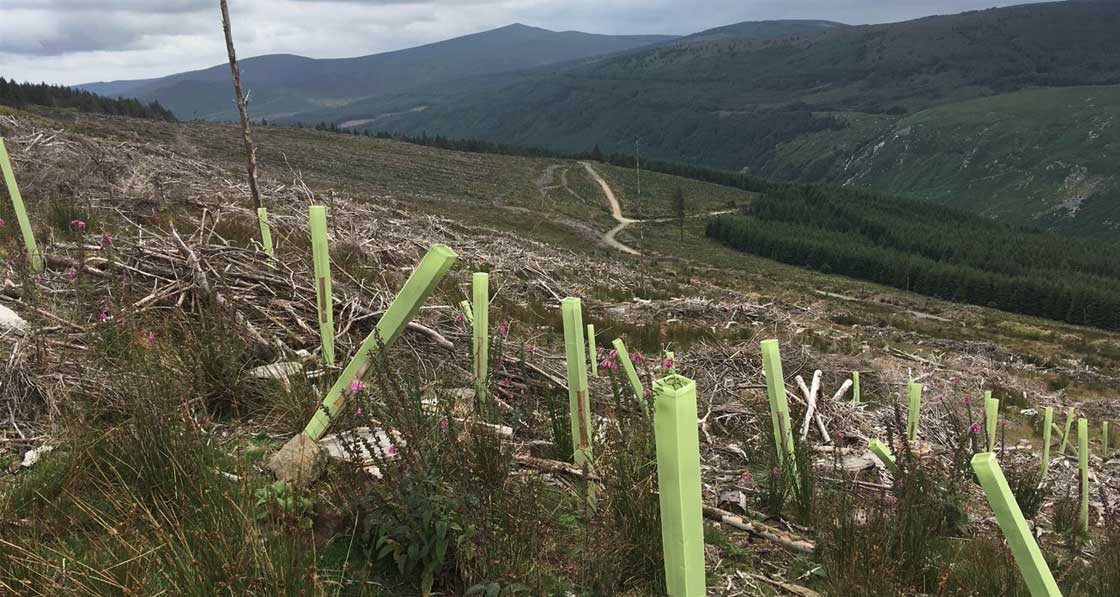
Recent analysis, though the subject of much debate, suggests that the size of forest clear-cuts in Europe increased by approximately 30 per cent from the period 2011-2015 to 2016-2018.
Demand for biomass for energy and materials has grown in Europe since 2000, and over 70 per cent of this comes from forestry (growth of bioenergy has been particularly rapid, to meet renewable energy targets), According to a recent report from the consultancy Material Economics, by 2050 demand for biomass in the EU 27 and UK will exceed available supply by 40 to 70 per cent. Recent analysis, though the subject of intense debate, suggests that the size of forest clear-cuts in Europe increased by approximately 30 per cent from the period 2011-2015 to 2016-2018. The rate of afforestation is also slowing, and the European Commission’s latest State of Nature report, published last year, says that: “the increased extraction of forest products and intensified forestry practices have diverse impacts on the various habitats and species protected under the nature directives.”
It also says: “Over the last few centuries, forests managed to varying degrees of intensity have replaced almost all of Europe’s natural forests. Currently, less than one third of Europe’s forests are uneven-aged, 30 per cent have only one tree species (mainly conifers), 51 per cent have only two to three tree species, and only 5 per cent of forests have six or more tree species.” One major 2018 study of forests across northern Europe concluded that, in general, the more efficiently a forest produces wood, the less effective it as at conserving biodiversity.
In Sweden, natural forests are being systematically clear-cut and replaced with even-aged plantations, according to five environmental NGOs. Recent logging of protected forests has also been reported in Estonia, Lithuania, and Romania. And with extractive demand on land increasing, nature is more at risk of being squeezed out.
So, while supporting a move from concrete and steel to timber and other natural fibres, our primary goal should be to dramatically reduce the quantity of raw materials needed in the first place. When specifying timber or other natural materials, how efficiently they are used can minimise the pressure on landscapes. As well as prioritising reclaimed or recycled materials where possible, smart choice of build system matters too.

The UK and Ireland are among the least forested countries in Europe, meaning there is potential for new forests of all types, from ecologically-minded timber production to those purely set aside for nature. See the ‘Home Grown Homes’ programme delivered by Wood Knowledge Wales for an example of a project that has aimed to develop a market for locally grown construction timber. Image source: European Environment Agency
For example, when comparing types of timber construction, one recent review concluded: “For buildings up to about six storeys, CLT uses substantially more timber to achieve the same function as a light timber frame building. For buildings over six stories, the use of CLT together with light timber frame may use less timber than CLT alone, and for buildings taller than ten stories, the only proven system to date is the external glulam frame supporting internal CLT units.” Exploring the use of DLT (dowel laminated timber) as a glue-free alternative to CLT also offers potential for improving on ‘mass timber’ practice.
The new systems view of life should form the conceptual framework for how we view materials derived from the natural world
Reducing our use of biomass-based fuels (in favour of energy efficiency and cleaner renewables) and of shorter-lived forest products (through efficiency, recycling and making do with less, rather than by replacing them with plastic) might allow us to use a greater proportion of our forests for long-lasting construction timber. In the UK and Ireland, which have some of the lowest tree cover in Europe, there is no doubt room for more forests of all types, both for ecologically-minded timber production, and to be set aside for nature. There may also be potential for designers, foresters, and ecologists to explore together the potential for under-utilised forestry products that could be harvested sustainably, such as forestry wastes, lower grade timber, small diameter trees removed during thinning, coppiced poles, and bamboo, reeds, and grasses. (We would like to see much closer collaboration between the building industry and ecologists in general).
5. Upskill, measure the carbon, be honest
Measure embodied carbon as transparently and accurately as possible, along with embodied energy. Be open and transparent. Quantify carbon emissions and stored carbon clearly and separately rather than combining them into one figure.
6. Become a systems thinker
In his profound and influential book, The Patterning Instinct, the systems thinker Jeremy Lent outlines in painstaking detail how the metaphor of nature as a machine to be engineered, rather than something living and animate, became one of the root metaphors of western civilisation — one that has now ultimately expressed itself in all manner of ecological destruction.

The density of structural timber used to achieve a given height of building for various structural systems. Source: ‘The wood from the trees: the use of timber in construction’, Renewable and Sustainable Energy Reviews, Volume 68, Part 1, February 2017, Pages 333-359.
Lent writes: “The approach to the natural world encouraged by reductionist thinking—conquering nature and nature as machine — has created imbalances that are becoming increasingly unstable. As we peer into the future, the threat of uncontrolled climate change looms, in addition to other impending global crises such as deforestation, freshwater scarcity, and an accelerated extinction of species.”
It would be a mistake to view whole landscapes, crops, trees, forests, or natural materials purely as a machine for human utility — whether the function of that machine to be provide food, building materials, or carbon sequestration.
Lent calls for a new worldview, “based on the emerging systems view of life—recognizing the intrinsic interconnectedness between all forms of life on earth and seeing humanity as embedded integrally within the natural world.” This new systems view should form the conceptual framework for how we view materials derived from the natural world.
7. Connect with the forest
Of course, make sure your wood is properly certified. But if any of it is locally grown, can you visit and build a connection with the forest where it grew, and with the people who grew and processed it? What can you learn about environmental issues and forest management in the regions it is sourced from? Can you specify wood from forests where managers are actively practicing ‘close to nature’ forestry or engaging in ecological restoration? (see for example www.prosilva.org).
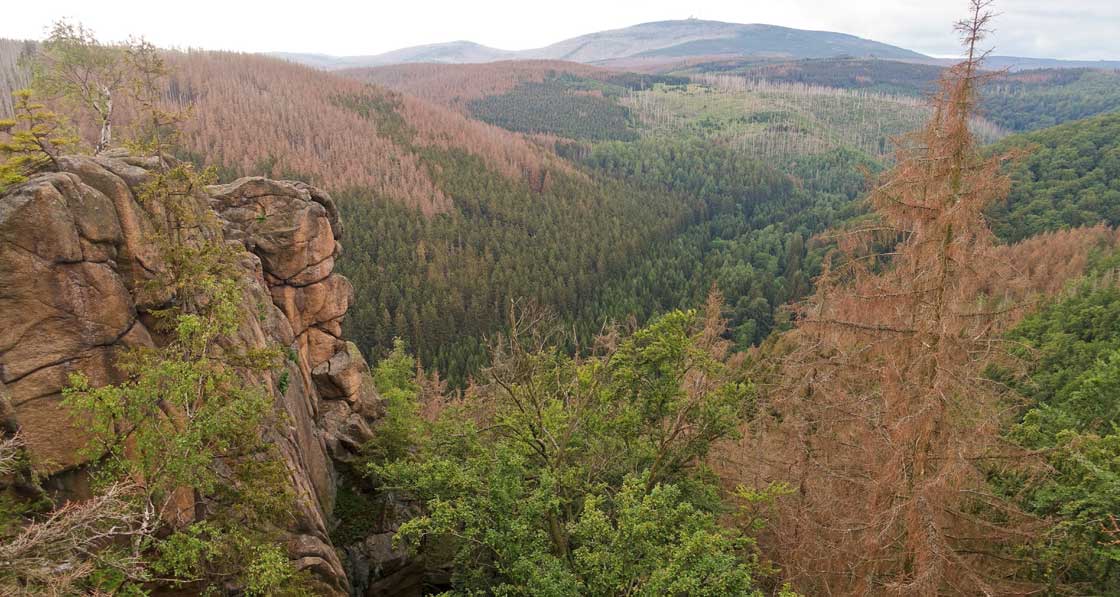
Spruce forest affected by bark beetle outbreak in the Harz, Germany.
The future of building materials
Ultimately, we should not view timber as the end-game for ecological construction materials either. Natural materials such as straw, mud and hemp — long overlooked — are worthy of much further research and market development. And in the future, innovative factory-based biotechnologies using bacteria and fungi could allow us to produce buildings using far less land and resources.
Scientists have already used E.coli to produce both limestone and styrene, the chemical used to make polystyrene, one of the most common insulation materials. Cyanobacteria have also been used to grow a bio-based structural building material. Building materials based on fungi also have the potential to create safe, low carbon materials that sequester carbon using agricultural and industrial wastes, though there is still a long way to go for these technologies.
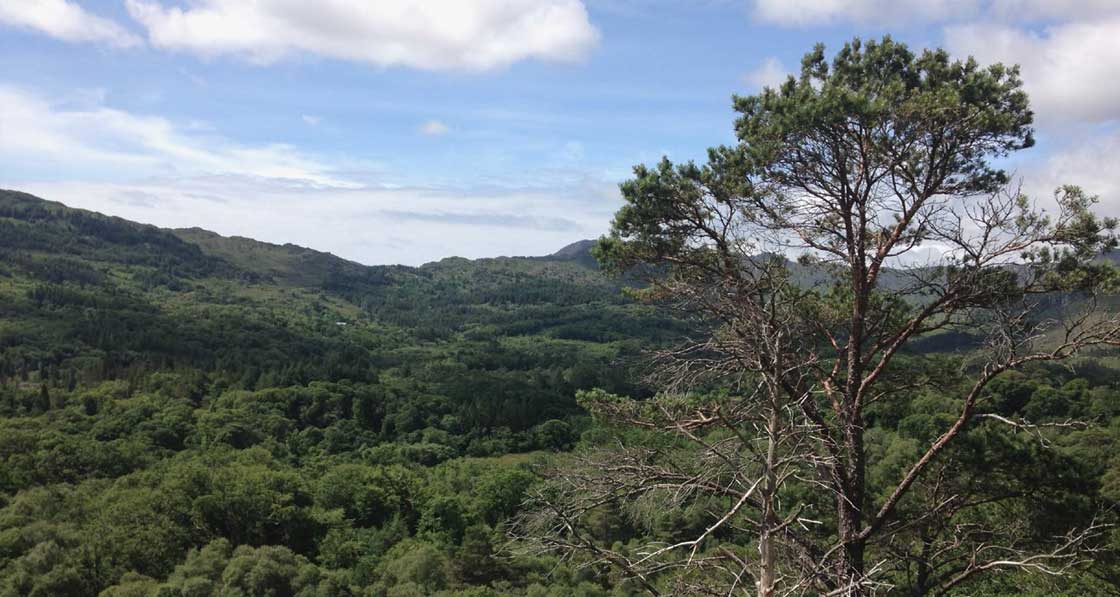
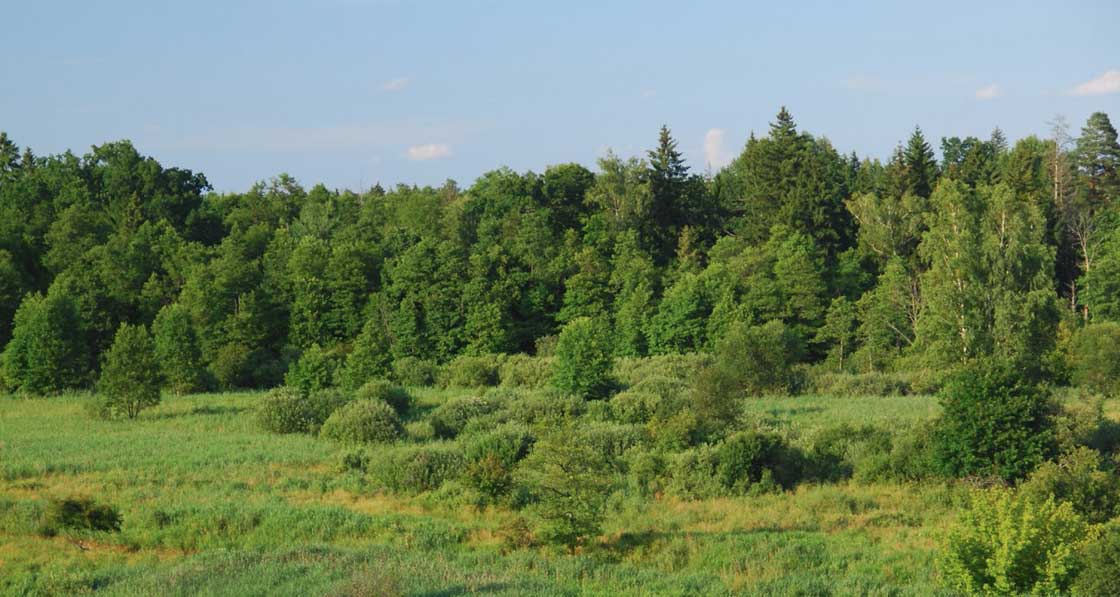
(above) Białowieza, one of Europe’s last large remaining tracts of old growth forest; (top) the Glengarriff Valley in County Cork harbours some of the most extensive woodland in Ireland, with a core of ancient oak forest surrounded by naturally regenerating native woodland and areas of conifer plantation.
“All construction is likely to warm the climate”
An insightful paper published earlier this year that uses dynamic life cycle assessment to compare the climate impact of concrete, steel and timber buildings, concludes with a warning that “any form of construction is likely to warm the climate”. The authors, all experts in the fields of sustainable engineering and energy, state that the primary aim of the construction sector should now be to “avoid new construction unless the societal benefits are clearly justified”.The paper says widespread adoption of timber over steel and concrete in buildings can substantially reduce — but not eliminate — climate impacts, provided the timber is from sustainably managed forests. It also adds: “This raises the question of resource availability: what are the wider potential impacts of increased timber demand? Planting new forest may be appropriate in some locations, but competing land demands for food production, urban space and biodiversity should not be overlooked.” It notes that many developing countries, where most new construction is anticipated, are those where sustainable timber supplies are under most pressure.
It calls for researchers and designers to work more closely with forest managers to develop timber buildings and supply chains that are responsive to the sustainable management of local forests.
The paper also says: “The climate benefits of timber components improve the longer that their stored biogenic carbon is prevented from re-entering the atmosphere. Structural engineers should therefore exert whatever influence they can to maximise longevity of building structures and create opportunities for reuse, whilst also reusing existing buildings wherever possible.”
This article was funded by the Association for Environment Conscious Building.





